
Iron Age Finds near York
- Details
- Category: History
- Created on Thursday, 13 September 2018 11:39
- Written by Northern Living
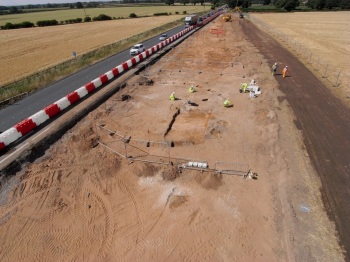 Our ancestors have lived in the immediate vicinity of York since the Neolithic period (c.4000 – 2000 BC). Much of the surrounding Vale of York was probably unsuitable for settlement at this time because of its poorly drained and heavy clay soil which made farming difficult.
Our ancestors have lived in the immediate vicinity of York since the Neolithic period (c.4000 – 2000 BC). Much of the surrounding Vale of York was probably unsuitable for settlement at this time because of its poorly drained and heavy clay soil which made farming difficult.
However, parts of the city, including the main campus of York University, sit on a moraine, a ridge of high ground left behind by retreating glaciers after the last Ice Age. This provides well-drained and sandy soils which were probably cultivated throughout prehistory. The moraine also offered a usable route joining the Yorkshire Wolds to the east and the Yorkshire Dales to the west.
Little is known of York in the Iron Age (c. 750 BC – AD 71), although when the Romans arrived it is known that they found a cultivated landscape not unlike parts of the valley of the river Ouse in nearby rural areas today. The Roman name for York, Eburacum, probably derives from a native name meaning the place of the yew trees. Helping to fill this gap in out historic understanding of the area is the discovery of a prehistoric settlement believed to date back 2,500 years unearthed on the ring road in York in July this year. City of York Council and York Archaeological Trust made the find at the Wetherby Road roundabout on the A1237 during junction improvements.
A large ring ditch, described as "One of the biggest to be unearthed in York", was found, along with fragments of pottery. Other finds included fragments of volcanic rock which does not occur locally, in what is believed to be a hearth pit. Ian Milsted, Head of Archaeology for York Archaeological Trust, said 'We're excited to have recovered this important information and will now analyse the finds to understand the story of the people who lived here before the Romans founded the city.
Finds have also been made to the north of the enclosure with a series of other ditches that may indicate field boundaries associated with the settlement.
The Stamford Bridge Tapestry Project
- Details
- Category: History
- Created on Saturday, 13 August 2016 11:39
- Written by Northern Living
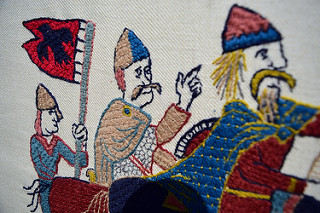 The Stamford Bridge Tapestry will commemorate the Battle of Stamford Bridge (September 25, 1066), when the Saxons defeated the Vikings so comprehensively that almost an entire generation of Viking warriors was wiped out. If the Saxon troops had not had to fight the Battle of Stamford Bridge, they would almost certainly have been victorious at the Battle of Hastings, less than a month later, and British history would have been very different.
The Stamford Bridge Tapestry will commemorate the Battle of Stamford Bridge (September 25, 1066), when the Saxons defeated the Vikings so comprehensively that almost an entire generation of Viking warriors was wiped out. If the Saxon troops had not had to fight the Battle of Stamford Bridge, they would almost certainly have been victorious at the Battle of Hastings, less than a month later, and British history would have been very different.
This year is the 950th anniversary of the battles of Fulford, Stamford Bridge and Hastings. Stitchers in Fulford have already completed the Fulford Tapestry; the Stamford Bridge Tapestry will complete the story of these three crucial battles of 1066.
Like the Bayeux Tapestry, our tapestry is actually an embroidery, stitched in wool, on linen. It has been designed in the style of the Bayeux Tapestry by Chris Rock, Chairman of the Battle of Stamford Bridge Heritage Society, of which the tapestry project is a part.
It is being stitched by a team of volunteers under the direction of Shirley Smith, a professional textile artist and Minster broderer. The intention is for it to become a national heirloom for Britain, in the same way as the Bayeux Tapestry is for France.
To see some of the work so far, please visit our Flickr group:
https://www.flickr.com/groups/3032987@N22/
To purchase items bearing images of the tapestry, please visit our Redbubble site:
http://www.redbubble.com/people/sbtapestry
To follow our progress, please see our Facebook page, Stamford Bridge Tapestry 1066
To contact the tapestry project to book talks and displays, please email:
This email address is being protected from spambots. You need JavaScript enabled to view it.
Roman remains hidden for the past 105 years are revealed in York
- Details
- Category: History
- Created on Saturday, 18 July 2015 17:58
- Written by Northern Living
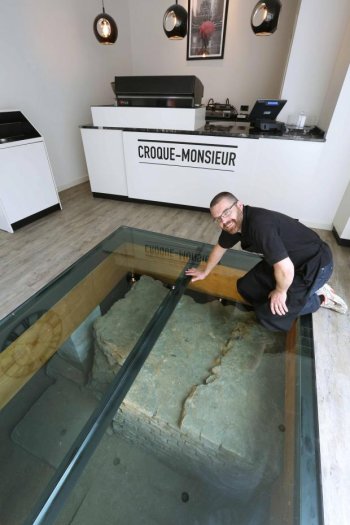 A corner of Roman York has been revealed during the creation of a new sandwich shop and cafe alongside Bootham Bar. Parts of the defences of the Roman legionary fortress Eburacum can be seen through a glass floor installed at Croque Monsieur, which is set to open shortly.
A corner of Roman York has been revealed during the creation of a new sandwich shop and cafe alongside Bootham Bar. Parts of the defences of the Roman legionary fortress Eburacum can be seen through a glass floor installed at Croque Monsieur, which is set to open shortly.
The fragment of stone wall formed part of the fortress wall built in the 2nd century AD, said city archaeologist John Oxley. "Today the wall stands approximately one metre high; it would originally have been at least four metres high," he said. "The stone is magnesian limestone, quarried in the Tadcaster area. It would have been taken by cart from the quarries to the River Wharfe and then brought to York by boat." He said a gateway was first constructed on the site in 71AD by the 9th Legion when it moved into the Vale of York during campaigns against the Brigantes.
He believed the gateway and wall probably survived into the 12th century when Bootham Bar was constructed. The remains were revealed and then recorded in 1910 during building works to create public toilets which formerly occupied the site, but the wall was then hidden away in a shallow basement under the men's toilet for more than 100 years.
"The replacement of the toilet facilities and creation of a new shop provided the opportunity to reveal this fascinating part of the Roman fortress defences to residents and visitors to York," he added. The shop and cafe is being opened by Chris Hartley and Colin Mustoe, who opened the city's first Croque Monsieur in Fulford Road earlier this year. Mr Hartley said the kitchens at Fulford Road would supply the city centre shop and at least one more, which he planned to open in York. He said the redevelopment of the Bootham Bar site had included the opening up of a window from the Bar which had been filled in for many decades, which gave passersby a view into the shop.
Enigmatic Sapphire Ring Found by a metal detectorist in York
- Details
- Category: History
- Created on Friday, 02 January 2015 18:49
- Written by Northern Living
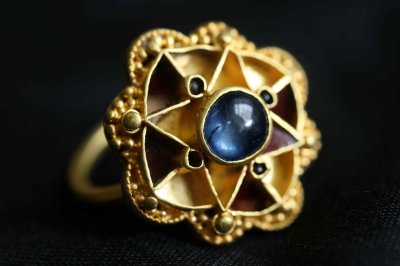 In January 2013 Scholars gathered in York to discuss an enigmatic sapphire ring found by a metal detectorist in 2009. The beaded gold piece, which is unlike any other in the museum's collection, may date to between the seventh and eleventh centuries A.D. "This beautiful ring has really got us puzzled," said Natalie McCaul, curator of archeology at the Yorkshire Museum. A jeweller who replicated the piece attended the meeting to explain how he remade the ring, and offered insights into how the original craftsman may have fashioned the unusual artefact.
In January 2013 Scholars gathered in York to discuss an enigmatic sapphire ring found by a metal detectorist in 2009. The beaded gold piece, which is unlike any other in the museum's collection, may date to between the seventh and eleventh centuries A.D. "This beautiful ring has really got us puzzled," said Natalie McCaul, curator of archeology at the Yorkshire Museum. A jeweller who replicated the piece attended the meeting to explain how he remade the ring, and offered insights into how the original craftsman may have fashioned the unusual artefact.
In the medieval period, wearing sapphires was a privilege reserved for royalty, nobility, and high-ranking clergy. Then, as now, sapphires were thought to bring good fortune, mental clarity, and spiritual enlightenment to the wearer. The intricate gold beading combined with the use of sapphire on this ring found in York, England, could date it to the Viking period (tenth to eleventh centuries A.D.). However, the jewellery more likely dates to between the seventh and ninth centuries A.D. The use of gold inlaid with red and blue glass is typical of jewellery from East Anglia, a kingdom in eastern England first settled in the fifth century A.D. To make the ring more impressive and suitable for royalty, a jeweller used precious stones instead of red or blue glass.
The craftsmanship is very similar to some of the pieces found in The Staffordshire Horde for in July 2009, the largest-ever hoard of Anglo-Saxon gold found in a farmer's field in Staffordshire. Discovered by Terry Herbert, a metal detectorist, and then excavated by the Birmingham University Archaeology Unit, the hoard consists of more than 1,500 gold and silver items, all dating to the seventh century. The find is far larger than other significant Anglo-Saxon hoards, such as those discovered with the contemporaneous noble burials at Sutton Hoo in south eastern England. In the Staffordshire horde most of the artifacts are associated with warfare, including helmet fragments engraved with a frieze of running animals and elaborate gold sword hilts inlaid with garnets. In some cases, rivets were still attached to the hilt components, suggesting they were ripped off the weapons and hidden quickly.
Viking 'Ring Fortress' Discovered In Denmark
- Details
- Category: History
- Created on Sunday, 07 September 2014 06:18
- Written by Northern Living
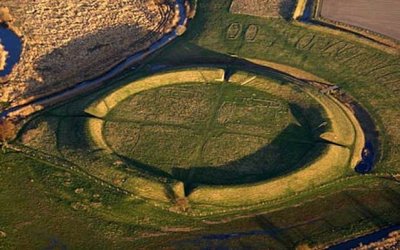 "Historians believe distinctive geometric fortresses may have been built by Sweyn Forkbeard as a military training camp from which to launch his invasion of England. Archaeologists in Denmark have discovered a distinctive ring-shaped Viking fortress which historians believe may have been used to launch an invasion of England. The fortress found on the Danish island of Zealand, around 30 miles south of Copenhagen, is the fifth circular fortress to be unearthed, and the first in over 60 years.
"Historians believe distinctive geometric fortresses may have been built by Sweyn Forkbeard as a military training camp from which to launch his invasion of England. Archaeologists in Denmark have discovered a distinctive ring-shaped Viking fortress which historians believe may have been used to launch an invasion of England. The fortress found on the Danish island of Zealand, around 30 miles south of Copenhagen, is the fifth circular fortress to be unearthed, and the first in over 60 years.
“This is great news,” said Lasse Sonne, a Viking historian from the Saxo Institute at the University of Copenhagen. “Although there were Vikings in other countries, these circular fortresses are unique to Denmark. Many have given up hope that there were many of them left.”
Like previously discovered ring fortresses, the Vallø Borgring is thought to date back to the late tenth century and the reign of Harald Bluetooth, the king who Christianised Denmark and Norway. However, some historians contend the fortresses were constructed by his son Sweyn Forkbeard, the first Danish King of England, as a military training camp or barracks from which to launch his invasions of England. Sweyn Forkbeard seized London in 1013 and was declared King of England on Christmas Day of that year.
The newly discovered fortress has a diameter of 475 feet, making it the third-largest of its type, and consists of a 35-foot wide circular rampart surrounded by a palisade of wooden spikes. Although only small portions of the new fortress have been uncovered, it appears to match the design of Denmark’s other ring fortresses, sticking to a strict geometric pattern. The fortresses have four gates facing outward in different compass directions, and an interior courtyard symmetrically divided into four quarters. It is thought that Viking “longhouses” would have been constructed within the fortress. Historians believe the geometric design may have been inspired by old Roman army camps found by Vikings during their raids on England. Denmark’s ring fortresses are also known as Trelleborgs, after the location of the first to be discovered in western Zealand. The other three are located in Aggersborg and Fyrkat in northern Jutland, and Nonnebakken near Odense."
From The Telegraph

